- images
- installation
- captions
- artist statement
- essays
Death
Palestine, 2011–12
series of 68 photographs,
38 x 57 cm; 57 x 38 cm; 66.7 x 100 cm; 100 x 66.7 cm; 100 x 150 cm,
chromogenic prints
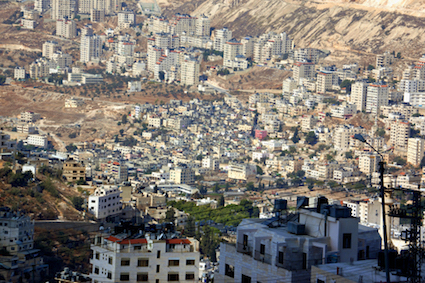 |
Ahlam Shibli, untitled (Death no. 1), Palestine, 2011–12, chromogenic print, 100 x 150 cm. 'Ala'in Refugee Camp west of the city center, Nablus, October 26, 2011. During the Second Intifada, Nablus was a center of Palestinian resistance to the Israeli occupation forces. The city includes four refugee camps admistrated by the UNRWA (United Nations Relief and Works Agency): Balata, Old Askar, New Askar, and 'Ala'in. The UNRWA gave the latter the name Camp No. 1. Locals, however, call it 'Ala'in referring to a water spring that served the refugees in the early days of the camp. 'Ala'in is known for its support of the Marxist-Leninist PFLP (Popular Front for the Liberation of Palestine), founded by George Habash in 1967. During the Second Intifada, the Israeli occupation forces killed more than 500 residents of Nablus and its refugee camps and injured more than 3,000. Some sixty houses were destroyed. Courtesy of the artist, © Ahlam Shibli
|
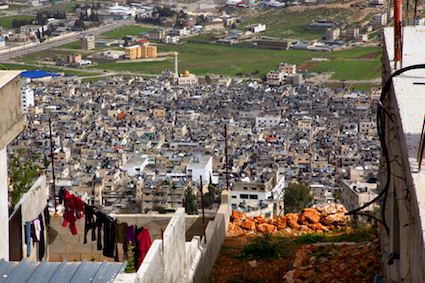 |
Ahlam Shibli, untitled (Death no. 2), Palestine, 2011–12, chromogenic print, 100 x 150 cm. Al-Dahiya neighborhood and the Balata Refugee Camp, Nablus, February 28, 2012. Inhabited by approximately 25,000 people on a quarter-square kilometer, Balata is one of the most densely populated areas in the world and the largest refugee camp in the West Bank. It is known as a stronghold of the Fateh, co-founded by Yasser Arafat (also known as Abu 'Amar) in 1959. Courtesy of the artist, © Ahlam Shibli
|
 |
Ahlam Shibli, untitled (Death no. 3), Palestine, 2011–12, chromogenic print, 100 x 66.7 cm. Rafediya neighborhood, Street 15, Nablus, February 22, 2012. A sit-in front of the Nablus Red Cross offices, organized by the DFLP (Democratic Front for the Liberation of Palestine) in support of the hunger strike of Palestinians in Israeli administrative detention protesting their confinement. On April 17, a general hunger strike was announced which terminated on May 14 when the Israeli government agreed to remove solitary confinement, to allow family visits from the Gaza Strip, and to suspend administrative detention. Courtesy of the artist, © Ahlam Shibli
|
 |
Ahlam Shibli, untitled (Death no. 4), Palestine, 2011–12, chromogenic print, 38 x 57 cm. The Old City, al-Kasaba neighborhood, Nablus, March 10, 2012. The diary of the prisoner Diyaa al-Lidawi from Nablus, who wrote his address as "the central Majedo prison, the department of the glory making men." Al-Lidawi's diary expresses his mourning for the absence of freedom and independence of the homeland, and his love for his dear ones who appears as the mother, the father, the beloved woman, or Palestine itself. The pages of the diary articulate his sorrow in the name of his martyr comrades, among them Basim Abu Sariyah, Ameen Labada, Ihab Abu Salha, Jamal Shihada, Ahmad Abu Sharikh, and Fadi Qfeesha. Other pages carry a call to the people to stand up and get rid of the leaders busy with their slogans. "I was filled with longing for my mother, my homeland, my folk, and my neighbors / Together we chanted: Oh leaders of the people! Start off! Enough with condemnations / The captives from your people are killed in front of your eyes / But only slogans were heard from your side / Get up my people, move, to rescue your prisoners from hell / From the leaders we hear only a declaration followed by a slogan / With the excuse of the people's predicament, caused by the prolonged siege / Our leaders will keep appeasing our folk with explanations / Promise that after me, you will keep the commandments of the 'khityar.'" ["Khityar" signi es "the Old Man," meaning Yasser Arafat.] The pages of the diary were written during the year 2008. Courtesy of the artist, © Ahlam Shibli
|
 |
Ahlam Shibli, untitled (Death no. 5), Palestine, 2011–12, chromogenic print, 38 x 57 cm. The Old City, al-Kasaba neighborhood, Nablus, February 8, 2012. Two cards of commiseration sent by prisoners in the Israeli Gilboa prison to the family of the martyr Naif Abu Sharkh, who was their leader. One of them reads, "In the name of God the Merciful / We have written with light on our pages / So time has not forgotten, nor did we forget the covenant / Naif / 26. 6," the other reads, "[Eternity] is the heritage of men proceeding into history / The best of judges / Is when you get praise from the world's mouth / When your words resonate in the world's ears." The verses are from "Eternity," a poem by Ahmad Shawqi. The latter card is dated February 28, 2005, and signed by Ibrahim Hubaysh, Kheri Salamah, Qasem 'Awad, 'Amar Samhan, Tariq Dola, Abu 'Abed Khaddich, and Basil al-Bizreh. Courtesy of the artist, © Ahlam Shibli
|
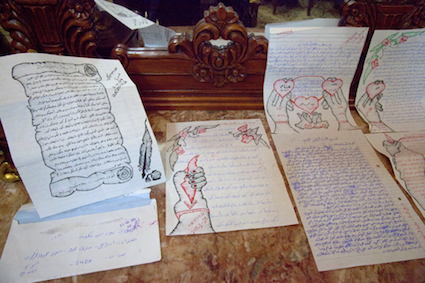 |
Ahlam Shibli, untitled (Death no. 6), Palestine, 2011–12, chromogenic print, 38 x 57 cm. The Old City, al-Qarioun neighborhood, Nablus, February 4, 2012. Letters by 'Ala' 'Akoubeh, sent from the central Majedo prison to his mother and his brother Hisham. The letters exhibit different kinds of handwriting and are always signed in Hebrew, which indicates that 'Akoubeh doesn't know how to write. In a letter dated December 21, 2010 he inquires about his brother's son Muhannad, guessing that he must be like himself, emotional and passionate. He asks his brother to send his wife with his son to the court, because 'Akoubeh would love to see his nephew. In another letter, dated July 17, 2010, 'Akoubeh writes, "My dear brother Hisham, the best brother in the world... since I am in prison I made you suffer, because the army came to your house. Please forgive me. And forget what you are busy with, at the end nothing helps you, neither girls nor alcohol." Courtesy of the artist, © Ahlam Shibli
|
 |
Ahlam Shibli, untitled (Death no. 7), Palestine, 2011–12, chromogenic print, 57 x 38 cm. The Old City, al-Kasaba neighborhood, Nablus, August 11, 2012. Letters and cards from prisoners to their supporter, the "mother of the resistance." During the Second Intifada, she put her work, her house, and her supplies at the disposition of any member of the resistance who knocked at her door. A greeting card reads, "I don't know where the comrades meet. Is it in the prison or in the grave or in the shadow of a State?" One letter to the "mother of the resistance" is written by the prisoners Nader and Mawjoud. They alternate lines—one writes in black, the other in blue. Courtesy of the artist, © Ahlam Shibli
|
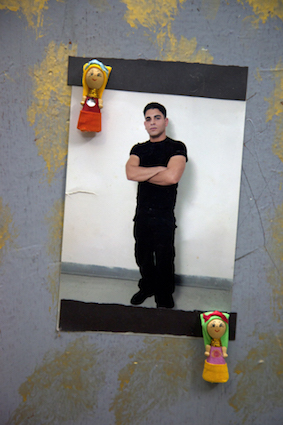 |
Ahlam Shibli, untitled (Death no.8), Palestine, 2011–12, chromogenic print, 57 x 38 cm. Balata Refugee Camp, March 6, 2012. Photo of the prisoner Bashar Einab on the wall of his brother's bedroom. Once a month the political prisoners in the Israeli jails are photographed. They can buy these pictures and send them to their families. Courtesy of the artist, © Ahlam Shibli
|
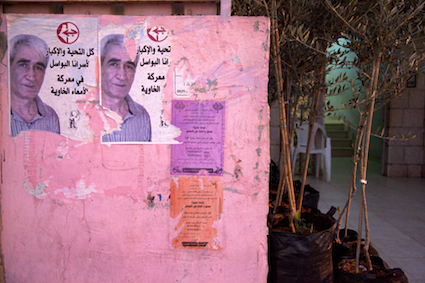 |
Ahlam Shibli, untitled (Death no. 9), Palestine, 2011–12, chromogenic print, 66.7 x 100 cm. Madama, region of Nablus, December 22, 2011. Posters of the imprisoned General Secretary of the PFLP (Popular Front for the Liberation of Palestine), Ahmad Sa'adat, in the village of Madama. Sa'adat was arrested after the PFLP had assassinated the Israeli Minister of Tourism, Rehavam Ze'evi, on October 17, 2001. The PFLP stated that the assassination was a revenge for the killing of their General Secretary Abu Ali Mustafa in August of the same year. Sa'adat was sentenced by an Israeli military court to thirty years in prison. Courtesy of the artist, © Ahlam Shibli
|
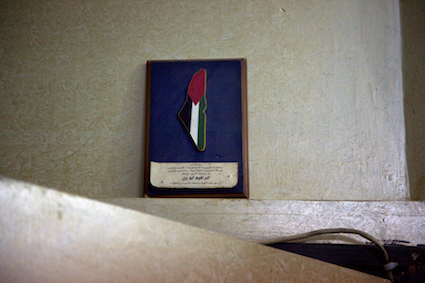 |
Ahlam Shibli, untitled (Death no. 10), Palestine, 2011–12, chromogenic print, 38 x 57 cm. Balata Refugee Camp, March 8, 2012. Frame containing a map of All-Palestine made from metal and painted in the Palestinian colors, "presented by the Fateh Youth Organization, region of Nablus, and the Student Youth Movement, Nablus schools, to the family of the hero prisoner Ibrahim Abu Zour, on the occasion of the Festival of the Covenant and the Fulfillment." Abu Zour was imprisoned for five years. Courtesy of the artist, © Ahlam Shibli
|
 |
Ahlam Shibli, untitled (Death no. 11), Palestine, 2011–12, chromogenic print, 38 x 57 cm. New Askar Refugee Camp, January 26, 2012. The entrance of the house of the Shalabi family with a wall painting from 2004 by one of the sons, Nour, who painted it after his brother 'Anan was arrested and sentenced for life. Nour was in the Israeli prisons from February 5, 2006 for five years. Thirteen members altogether of the Shalabi family have been in the Israeli prison or are currently still serving their sentences. Courtesy of the artist, © Ahlam Shibli
|
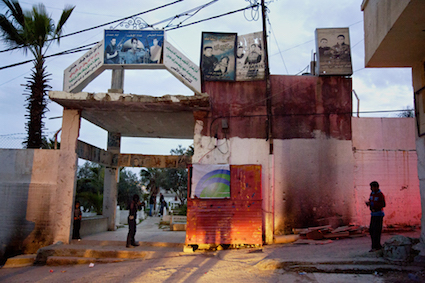 |
Ahlam Shibli, untitled (Death no. 12), Palestine, 2011–12, chromogenic print, 66.7 x 100 cm. Balata Refugee Camp, Old Graveyard, February 12, 2012. The entrance to the Old Graveyard. The graveyard is the only green area in the camp. It is used by the locals as a meeting place and a shortcut to the main road. The writing on the right side above the entrance reads, "Fight them; Allah will punish them by your hands and will disgrace them and give you victory over them and satisfy the breasts of a believing people. Al-Aqsa Martyrs' Brigades." On the left side it reads, "I am leaving, leaving with you my songs / and a wound that didn't touch my glory / and a lover's gaze and a child's cry and olives / breathing in my blood and I will give you my share in the world and leave." The posters represent martyred key figures from the Balata Refugee Camp branch of the al-Aqsa Martyrs' Brigades. Courtesy of the artist, © Ahlam Shibli
|
 |
Ahlam Shibli, untitled (Death no. 13), Palestine, 2011–12, chromogenic print, 66.7 x 100 cm. Western Graveyard, Nablus, January 20, 2012. Grave of Basim Abu Sariyah, known as al-Gaddafi. The Israelis tried seven times to assassinate him before he met his death. On his grave it reads that he was a leader of the al-Aqsa Martyrs' Brigades in the West Bank and founder of the Faris al-Leil (Knight of the Night) resistance groups in the Old City of Nablus, martyred in an armed fight with the Zionist enemy on October 16, 2007. Courtesy of the artist, © Ahlam Shibli
|
 |
Ahlam Shibli, untitled (Death no. 14), Palestine, 2011–12, chromogenic print, 38 x 57 cm. Madama, region of Nablus, December 13, 2011. The village graveyard with the tomb of Yamen Faraj, commander of the Abu Ali Mustafa Brigades in Palestine, the military wing of the PFLP (Popular Front for the Liberation of Palestine). He was killed on July 6, 2004 during an Israeli incursion into Nablus, together with his comrade Amjad Mulaitat from Beit Furik, a deputy commander of the Abu Ali Mustafa Brigades. As a punishment, the Israeli authorities demolished homes of the Faraj family and Mulaitat's house. Courtesy of the artist, © Ahlam Shibli
|
 |
Ahlam Shibli, untitled (Death no. 15), Palestine, 2011–12, chromogenic print, 38 x 57 cm. Western Graveyard, Nablus, January 20, 2012. In Nablus, the families of the deceased visit the graveyards on Thursday evening or Friday morning to take care of the tombs and sit next to them in commemoration. Usually members of the same family are buried close to each other, whether they died a martyr's death or of natural causes. Courtesy of the artist, © Ahlam Shibli
|
 |
Ahlam Shibli, untitled (Death no. 16), Palestine, 2011–12, chromogenic print, 38 x 57 cm. Western Graveyard, Nablus, December 11, 2011. The tomb of Amjad al-Hinnawi, a leader of the Ezzedeen al-Qassam Brigades in the Northern West Bank, killed on November 14, 2005. Hinnawi was one of the first explosives experts in the West Bank, and on the Israeli wanted list since 1996. The Ezzedeen al-Qassam Brigades are the military wing of Hamas. Courtesy of the artist, © Ahlam Shibli
|
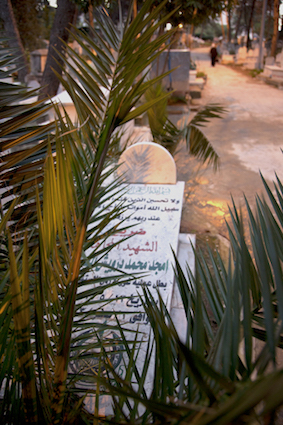 |
Ahlam Shibli, untitled (Death no. 17), Palestine, 2011–12, chromogenic print, 57 x 38 cm. Western Graveyard, Nablus, January 20, 2012. Tomb of Amjad al-Qotob, killed on May 13, 2002 during an attack on the Israeli military in the Jordan Valley. In the letter he left behind, he stated that his attack was in revenge of the "ugly Israeli massacres at the Jenin Refugee Camp and in Nablus." Courtesy of the artist, © Ahlam Shibli
|
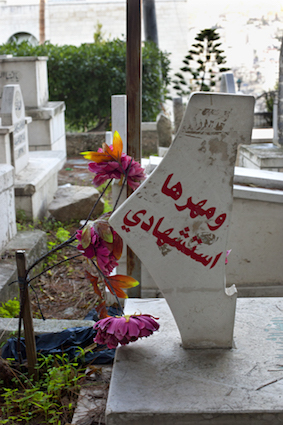 |
Ahlam Shibli, untitled (Death no. 18), Palestine, 2011–12, chromogenic print, 57 x 38 cm. Western Graveyard, Nablus, December 11, 2011. Tomb of 'Ala' al-Din al-Dawaya, member of the Jihad al-Islami (Palestinian Islamic Jihad), shot on December 18, 2003 in downtown Nablus. On the stone in the shape of Palestine it reads, "My martyrdom is her dowry." Courtesy of the artist, © Ahlam Shibli
|
 |
Ahlam Shibli, untitled (Death no. 19), Palestine, 2011–12, chromogenic print, 38 x 57 cm. Balata Refugee Camp, February 16, 2012. The family of the martyr converted their guest room into a memorial space for their son, the militant of the al-Aqsa Martyrs' Brigades, Khalil Marshoud, who was killed on June 14, 2004, together with his resistance comrade 'Awad Abu Zeid, by an Israeli air strike targeting the car they were traveling in that night. On the light box poster with Marshoud's image it reads, "Cursed be the time lacking the honorable ones and ruled by cowards." Since he co-operated with fighters from groups other than his own, the room also contains photos of his with the emblems of various movements that were presented to the family. Additional photographs show different members of the resistance, his comrades. Courtesy of the artist, © Ahlam Shibli
|
 |
Ahlam Shibli, untitled (Death no. 20), Palestine, 2011–12, chromogenic print, 38 x 57 cm. The Old City, al-Kasaba neighborhood, Nablus, November 27, 2011. Photo of the martyr Amjad al-Hinnawi of the Ezzedeen al-Qassam Brigades at the house of the "mother of the resistance." On the same table, a photo of Nader Sadaka from the PFLP (Popular Front for the Liberation of Palestine) at a demonstration, as well as a familat a demonstration as well as a family photo of the "mother of the resistance" with her husband and grandchildren. Courtesy of the artist, © Ahlam Shibli
|
 |
Ahlam Shibli, untitled (Death no. 21), Palestine, 2011–12, chromogenic print, 38 x 57 cm. Balata Refugee Camp, March 6, 2012. In the family living room, a poster with the image of Ahmad Rashid Einab and his brother Rami. Rami Einab was a fighter and specialist in explosives, killed on December 19, 2006. Ahmad was a paramedic who was accidentally killed on July 21, 2006 in front of his house when the Israeli army destroyed the neighboring offices of the Palestinian Authority in Nablus. Courtesy of the artist, © Ahlam Shibli
|
 |
Ahlam Shibli, untitled (Death no. 22), Palestine, 2011–12, chromogenic print, 38 x 57 cm. Al-Am'ari Refugee Camp, region of Ramallah, October 18, 2011. Picture of Wafa Idris in her family's living room. The picture hangs underneath a framed piece of embroidery reading, "Trust in God," which is surrounded by a photo of Idris graduating as a paramedic and a photo of her brother Khalil, an activist against the occupation who spent eight years in Israeli prisons. Wafa Idris was the first woman to carry out a martyrdom operation in Israel. The al-Aqsa Martyrs' Brigades claimed responsibility for the attack, but subsequently different explanations for Idris's action were circulated. Courtesy of the artist, © Ahlam Shibli
|
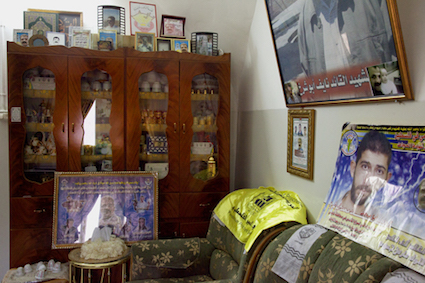 |
Ahlam Shibli, untitled (Death no. 23), Palestine, 2011–12, chromogenic print, 38 x 57 cm. The Old City, al-Kasaba neighborhood, Nablus, February 8, 2012. Memorabilia commemorating Naif Abu Sharkh, killed on June 26, 2004, alongside memorabilia of his martyred brother, his imprisoned two sons, and several cousins, in the guest room of Abu Sharkh's mother. Abu Sharkh was the leader of the al-Aqsa Martyrs' Brigades in Nablus who didn't agree to a truce with the Israelis to end the Second Intifada. The Israelis made him responsible for an attack in Tel Aviv in 2003, put him on the top of their wanted list, destroyed his house, and arrested his wife and sons. Abu Sharkh was killed together with members of different resistance groups after hiding for three weeks in the underground of Nablus. As a consequence, his mother's guest room contains memorial items not only from the al-Aqsa Martyrs' Brigades. Courtesy of the artist, © Ahlam Shibli
|
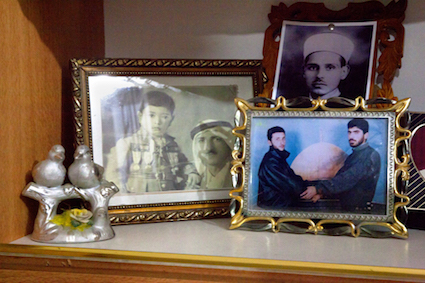 |
Ahlam Shibli, untitled (Death no. 24), Palestine, 2011–12, chromogenic print, 38 x 57 cm. 'Asira al-Shamaliya, north of Nablus, December 23, 2011. Buffet in the house of the Jara'arah family, where a photo of the son Mu'awiya and his comrade Yusif Showley is displayed together with family photos. The men took the photo before each of them participated in a martyrdom operation in Israel. Both operations were carried out in the name of the group "Martyrs for Prisoners." They were planned by the number one on the Israeli wanted list, Mahmoud Abu Hanoud, a commander of the Ezzedeen al-Qassam Brigades in the West Bank, the military wing of Hamas, the Islamic Resistance Movement. Abu Hanoud was assassinated on November 24, 2001 by an Israeli Apache helicopter while traveling in his car north of Nablus. The two martyrdom operations were carried out with a difference of one month at the same location in West Jerusalem. Mu'awiya Jara'arah accomplished the first operation on July 30, 1997 together with Tawfiq Yassin. As a consequence of the attack, the occupation forces filled several floors of the house of the Jara'arah family with concrete to make them unusable, and destroyed the house of the Yassin family. The second martyrdom operation was carried out on September 4, 1997 by Yusif Showley, Bashar Sawalha, and Khalil Sharif. As a punishment for the attack, the occupation forces destroyed their family houses. The bodies of Showley, Sawalha, Sharif, Yassin, and Jara'arah were buried in an Israeli "Cemetery of Numbers" and returned to their families together with the bodies of other Palestinian militants on May 31, 2012. After Mu'awiya Jara'arah's martyrdom operation, Israel, on July 30, 1997, made the decision to carry out assassinations of the leaders of Hamas. The second martyrdom operation strengthened Israel's determination to achieve quick retaliation, and they decided to target Khaled Mesh'al, the head of the political bureau of Hamas, in Amman, Jordan. The Mossad's assassination attempt of Khaled Mesh'al on September 25, 1997, failed. Courtesy of the artist, © Ahlam Shibli
|
 |
Ahlam Shibli, untitled (Death no. 25), Palestine, 2011–12, chromogenic print, 57 x 38 cm. Al-Dahiya neighborhood, Nablus, February 27, 2012. Memorial items in the family guest room commemorating Sami 'Antar who died on January 19, 2006 during a martyrdom operation in Tel Aviv. He was a student in his second year of physical education studies at An-Najah National University in Nablus. His body was buried in an Israeli "Cemetery of Numbers" and returned to his family together with the bodies of other Palestinian militants on May 31, 2012. Courtesy of the artist, © Ahlam Shibli
|
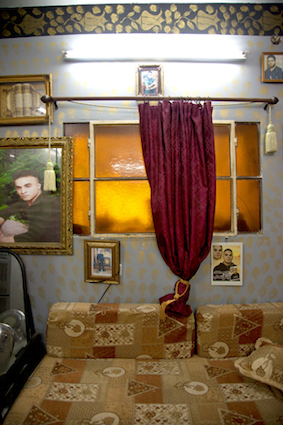 |
Ahlam Shibli, untitled (Death no. 26), Palestine, 2011–12, chromogenic print, 57 x 38 cm. Balata Refugee Camp, March 6, 2012. Room of Morad, the brother of Ahmad, Rami, and Bashar Einab, with photos of himself and his brothers. For four years Morad has been on the Israeli wanted list and therefore cannot leave the house. Courtesy of the artist, © Ahlam Shibli
|
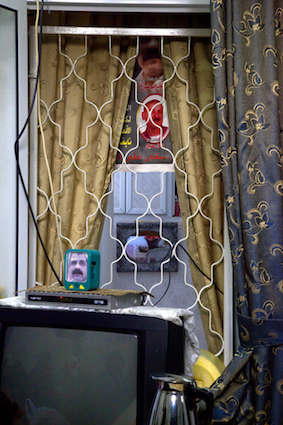 |
Ahlam Shibli, untitled (Death no. 27), Palestine, 2011–12, chromogenic print, 57 x 38 cm. The Old City, al-Kasaba neighborhood, Nablus, February 8, 2012. A photo of the martyr Naif Abu Sharkh on the alarm clock in his mother's bedroom. The poster in the back pictures his brother, Rassan Abu Sharkh with Ra'ed al-Sarakji and 'Anan Sobh who were assassinated together on December 26, 2009 by the Israelis to avenge previous attacks. The poster also includes a picture of Naif Abu Sharkh, their leader. Courtesy of the artist, © Ahlam Shibli
|
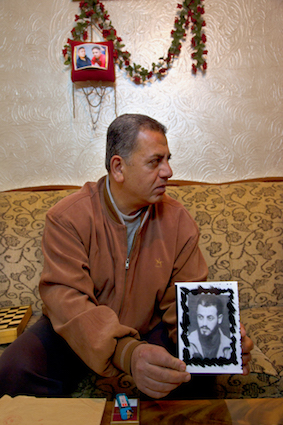 |
Ahlam Shibli, untitled (Death no. 28), Palestine, 2011–12, chromogenic print, 57 x 38 cm. Balata Refugee Camp, March 6, 2012. The brother of Nasser Auwais, holding the latter's photo. Nasser Auwais was wanted by the Israelis, because he was one of the founders of al-Aqsa Martyrs' Brigades and later their General Secretary in Palestine. He is considered responsible for several attacks and martyrdom operations. Auwais was arrested on April 13, 2002, and given thirteen life sentences plus fifty years in prison. He is currently being subjected to solitary confinement without the right of family visits. Courtesy of the artist, © Ahlam Shibli
|
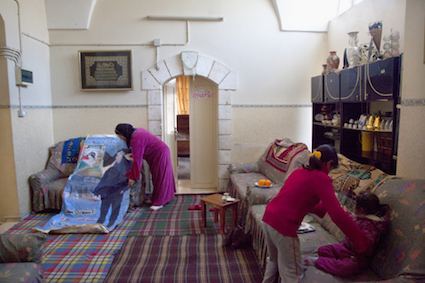 |
Ahlam Shibli, untitled (Death no. 29), Palestine, 2011–12, chromogenic print, 38 x 57 cm. The Old City, al-Yasmina neighborhood, Nablus, February 28, 2012. Living room with the martyr's mother showing a poster of her son Sa'ed 'Awada, while her daughter is taking care of the youngest sister who suffers from Down syndrome. 'Awada was a member of al-Aqsa Martyrs' Brigades and carried out a martyrdom operation on June 18, 2002 in Jerusalem. Before leaving Nablus he had a photo taken which was used for the poster. The house of the family was destroyed during an Israeli incursion even before 'Awada's attack. Courtesy of the artist, © Ahlam Shibli
|
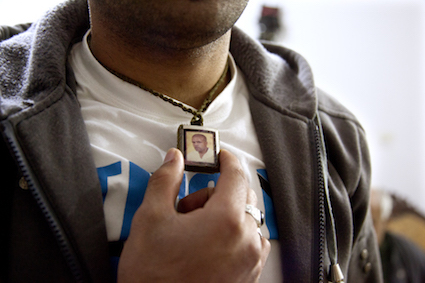 |
Ahlam Shibli, untitled (Death no. 30), Palestine, 2011–12, chromogenic print, 38 x 57 cm. 'Ala'in Refugee Camp, February 28, 2012. Mohammad Khalid, a recently freed prisoner, showing the photo of his friend from the resistance, the martyr Firas Abu al-Rish. Abu al-Rish was assassinated, together with his brother 'Adel, in his car by Israeli special forces on October 17, 2006. Courtesy of the artist, © Ahlam Shibli
|
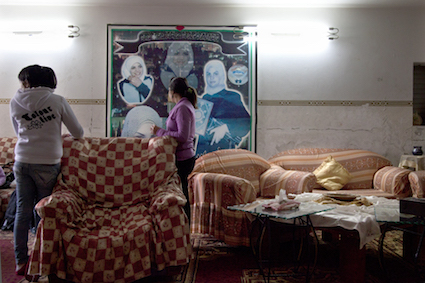 |
Ahlam Shibli, untitled (Death no. 31), Palestine, 2011–12, chromogenic print, 38 x 57 cm. Old Askar Refugee Camp, February 15, 2012. The family guest room with the picture of Zeinab Abu Salem who carried out a martyrdom operation in Jerusalem on September 22, 2004. Abu Salem had just passed high school graduation exams. She was the eighth woman to carry out such an attack. The Israeli army destroyed the family house as a punishment. Her body was returned to the family on May 31, 2012. Courtesy of the artist, © Ahlam Shibli
|
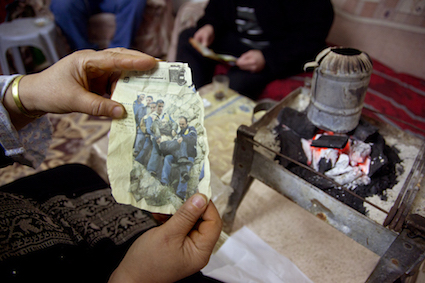 |
Ahlam Shibli, untitled (Death no. 32), Palestine, 2011–12, chromogenic print, 38 x 57 cm. The Old City, al-Kasaba neighborhood, Nablus, December 1, 2011. The "mother of the resistance" holding a newspaper cut-out with a picture of the dead Jebril 'Awad from the town Awarta, southeast of Nablus, known for its support of the PFLP (Popular Front for the Liberation of Palestine). 'Awad was an explosives specialist and had to leave University for the fact that he had been on the Israeli wanted list for three years. Five members of his family were killed by the occupation forces. 'Awad was killed in a clash with the Israeli army on December 18, 2003 in a park in the Old City of Nablus where he had been hiding together with other resistance fighters. Courtesy of the artist, © Ahlam Shibli
|
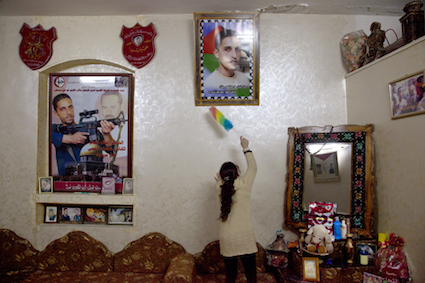 |
Ahlam Shibli, untitled (Death no. 33), Palestine, 2011–12, chromogenic print, 38 x 57 cm. Balata Refugee Camp, February 16, 2012. Photos of the martyr Khalil Marshoud in the family living room being dusted by his sister. On the poster, a gift from the Abu Ali Mustafa Brigades, he is called the General Secretary of the al-Aqsa Martyrs' Brigades of Balata. Courtesy of the artist, © Ahlam Shibli
|
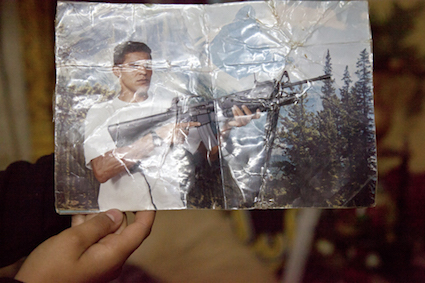 |
Ahlam Shibli, untitled (Death no. 34), Palestine, 2011–12, chromogenic print, 38 x 57 cm. Balata Refugee Camp, February 12, 2012. A photo of Kayed Abu Mustafa, called Mikere, presented by his daughter. Abu Mustafa was killed on February 28, 2002. Courtesy of the artist, © Ahlam Shibli
|
 |
Ahlam Shibli, untitled (Death no. 35), Palestine, 2011–12, chromogenic print, 100 x 66.7 cm. Balata Refugee Camp, March 8, 2012. The mother of a prisoner who was recently freed after three years of administrative detention, Mohammad Abu Zour. She is also the mother of Mohannad Abu Zour, who carried out a martyrdom operation on May 31, 2002 at the settlement Shavei Shomron west of Nablus, avenging the killing of Mahmoud al-Titi, a resistance leader of the Balata Refugee Camp. Abu Zour arrived at the settlement, but was detected and shot dead before he could carry out his attack. The Israelis destroyed the house of the family as a punishment. The martyr's mother is showing a poster with images of martyrs who are missing or being kept by the Israeli occupation state. At the top of the poster it reads, "We have names and we have a homeland." Courtesy of the artist, © Ahlam Shibli
|
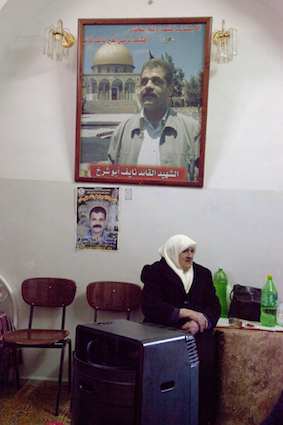 |
Ahlam Shibli, untitled (Death no. 36), Palestine, 2011–12, chromogenic print, 100 x 66.7 cm. The Old City, al-Kasaba neighborhood, Nablus, February 8, 2012. The room of the mother of the martyrs Naif and Rassan Abu Sharkh, with the former on the larger and the latter on the smaller poster. The depicted woman is a visitor. Courtesy of the artist, © Ahlam Shibli
|
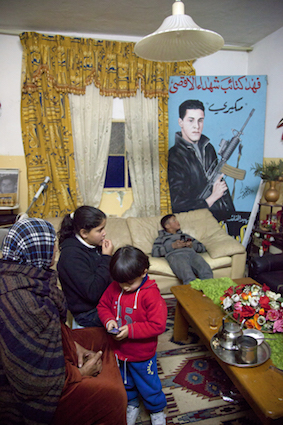 |
Ahlam Shibli, untitled (Death no. 37), Palestine, 2011–12, chromogenic print, 100 x 66.7 cm. Balata Refugee Camp, February 12, 2012. A canvas in the guest room of the family of Kayed Abu Mustafa, depicting the martyr. It reads, "The panther of Kata'ib Shuhada' al-Aqsa, Mikere" (Mikere, of al-Aqsa Martyrs' Brigades). The people in the room are Mikere's mother, his little nephew and his two children. Courtesy of the artist, © Ahlam Shibli
|
 |
Ahlam Shibli, untitled (Death no. 38), Palestine, 2011–12, chromogenic print, 100 x 66.7 cm. New Askar Refugee Camp, June 28, 2012. The guest room of the family of Osama Bushkar with his brother and his nephew. Bushkar carried out a martyrdom operation on May 19, 2002 in Natanya. He approached different resistance organizations, which refused to equip him for the operation because he was too young. Finally the Abu Ali Mustafa Brigades accepted him. His body is still in the hands of the Israeli authorities. The army destroyed his family's house as punishment. Courtesy of the artist, © Ahlam Shibli
|
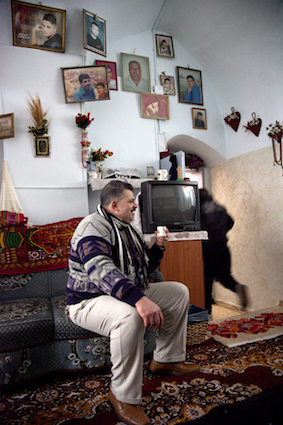 |
Ahlam Shibli, untitled (Death no. 39), Palestine, 2011–12, chromogenic print, 100 x 66.7 cm. The Old City, al-Kasaba neighborhood, Nablus, February 4, 2012. The living room of the grandmother of the martyr Shadi Kelani with his father. On the wall are pictures of her sons and her grandson, the martyr. Kelani was the goal-keeper of the Sport Union Club of Nablus and a member of the armed resistance groups Faris al-Leil (Knight of the Night). He was killed in a clash with the occupation forces on July 19, 2006 in Nablus. Courtesy of the artist, © Ahlam Shibli
|
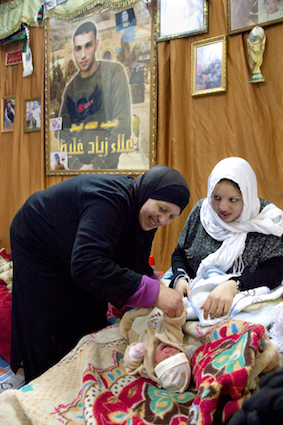 |
Ahlam Shibli, untitled (Death no. 40), Palestine, 2011–12, chromogenic print, 100 x 66.7 cm. The Old City, al-Qarioun neighborhood, Nablus, February 14, 2012. The room of the family of the martyr 'Ala' Ghalaid. His sister from Tulkarm gave birth in Nablus and is staying for three days with their mother. She named her newborn after her martyred brother. Ghalaid was a member of the resistance groups Faris al-Leil (Knight of the Night). He was the first to plant bombs against the Israeli army, in his own and al-Yasmina neighborhoods. He was killed in a clash with the Israeli army on March 27, 2007. Courtesy of the artist, © Ahlam Shibli
|
 |
Ahlam Shibli, untitled (Death no. 41), Palestine, 2011–12, chromogenic print, 38 x 57 cm. The Old City, al-Kasaba neighborhood, Nablus, February 5, 2012. A fruit and vegetable shop in front of the house of the mother of Naif Abu Sharkh, with different calendars exhibiting martyrs' images. The calendars are distributed to keep the memory of the martyrs alive. The large poster shows the martyr Mazen Freitakh and in the background the commander of al-Aqsa Martyrs' Brigades, Naif Abu Sharkh. Freitakh was a commander of the Martyrdom Unit and an explosives specialist. He prepared Sa'ed 'Awada for his martyrdom operation in Jerusalem on June 18, 2002. When the Israeli army invaded Nablus in 2002 they blew up his house killing two of his aunts and injuring two of his brothers as well as his sister, while he himself was able to escape. The poster has been published to commemorate the second anniversary of Freitakh's death. It reads, "The head of the Martyrdom Unit, Mazen Freitakh / The brain managing many military operations deep in the Zionist heart / The one responsible for killing many Zionist soldiers / Who was martyred in an armed clash with the Zionist occupation forces on April 15, 2003. // Be generous, Brigades, with the blood and bring light to the earth with your martyr heroism / Mazen, the heroism, the challenge, the sacrifice, the Sheikh of the resistance, the lion of the martyrs / With your fire you burn the enemy hordes, the roar of your bullet bends their pride / You will stay a castle of glory and disdain and you will stay the fighter refusing to bow." Courtesy of the artist, © Ahlam Shibli
|
 |
Ahlam Shibli, untitled (Death no. 42), Palestine, 2011–12, chromogenic print, 38 x 57 cm. Nablus, December 12, 2011. In a sewing workshop, a poster commemorating the death of Basim Abu Sariyah, known as al-Gaddafi, with Naif Abu Sharkh in the background. Courtesy of the artist, © Ahlam Shibli
|
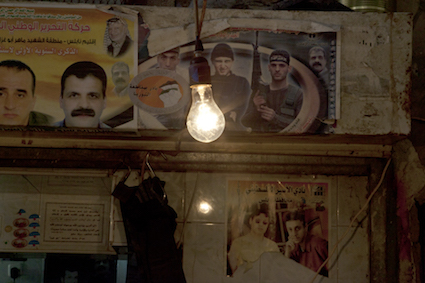 |
Ahlam Shibli, untitled (Death no. 43), Palestine, 2011–12, chromogenic print, 38 x 57 cm. The Old City, al-Kasaba neighborhood, Nablus, February 5, 2012. In a vegetable shop, posters of different martyrs. A poster joining Yasser Arafat, Naif Abu Sharkh, Mazen Abu Sharkh, and Ra'ed al-Sarakji has been published to commemorate one year since the death of Mazen and Ra'ed. A second poster shows three martyrs from the Faris al-Leil (Knight of the Night) resistance groups. Courtesy of the artist, © Ahlam Shibli
|
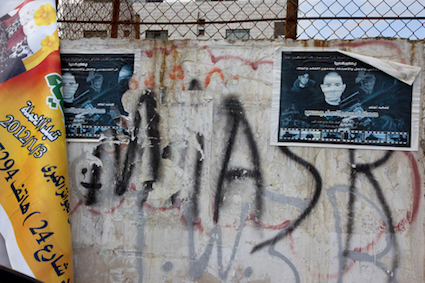 |
Ahlam Shibli, untitled (Death no. 44), Palestine, 2011–12, chromogenic print, 38 x 57 cm. Nablus, January 28, 2012. Posters commemorating 'Amar al-'Anabousi, a member of al-Aqsa Martyrs' Brigades who was shot dead on October 10, 2007 in the Old City of Nablus by Israeli special forces dressed in the uniform of Palestinian National Security officers. Courtesy of the artist, © Ahlam Shibli
|
 |
Ahlam Shibli, untitled (Death no. 45), Palestine, 2011–12, chromogenic print, 38 x 57 cm. Balata Refugee Camp, Old Graveyard, February 5, 2012. Posters commemorating Ahmad Sanakra, killed in a confrontation with the Israeli army on 18 January, 2008. The poster reads, "A man who made history and made of his biography a lighthouse of the resistance: a man who loved the homeland, and God loves him, a martyr." Courtesy of the artist, © Ahlam Shibli
|
 |
Ahlam Shibli, untitled (Death no. 46), Palestine, 2011–12, chromogenic print, 38 x 57 cm. Al-Yasmina neighborhood, Nablus, November 1, 2011. Hisham, a police officer and brother of the prisoner 'Ala' Akoubeh, sits in a coffee shop. The posters depict Basim Abu Sariyah, known as al-Gaddafi. Courtesy of the artist, © Ahlam Shibli
|
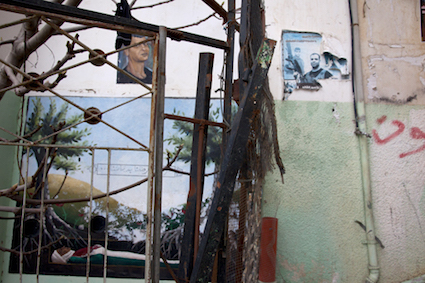 |
Ahlam Shibli, untitled (Death no. 47), Palestine, 2011–12, chromogenic print, 38 x 57 cm. Balata Refugee Camp, March 7, 2012. Attached to the house of the family, a memorial for the martyr Hamouda Shtewei. On the wall, a painting of the martyr in his grave, enshrouded in the Palestinian colors, with olive trees growing from it; above the painting, a portrait of him. Often such memorials are adorned with plants and trees to symbolize the continuation of life. At Shtewei's memorial, it is a fig tree. Up above, the family has hung a poster of Shtewei from their balcony, saying, "Many carry a weapon, but few bring it to the chest of the enemy." Shtewei was a fighter and on the Israeli wanted list. He escaped several assassination attempts and was killed in a clash with the Israeli army in the refugee camp on February 22, 2006. Courtesy of the artist, © Ahlam Shibli
|
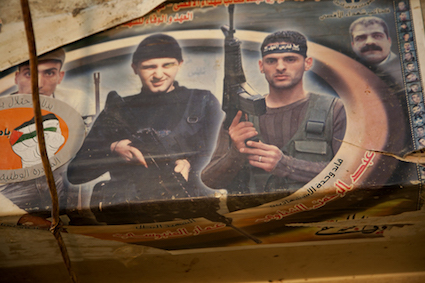 |
Ahlam Shibli, untitled (Death no. 48), Palestine, 2011–12, chromogenic print, 38 x 57 cm. The Old City, al-Kasaba neighborhood, Nablus, February 5, 2012. In a vegetable shop, a poster showing the martyrs 'Abd al-Rahman Shinnawi, 'Amar al-'Anabousi and Basim Abu Sariyah from the Faris al-Leil (Knight of the Night) resistance groups which belong to al-Aqsa Martyrs' Brigades. On the margins of the poster, a picture of Naif Abu Sharkh, the head of al-Aqsa Martyrs' Brigades in Nablus. The poster carries a sticker showing a raised fist with the Palestinian colors and reading, "We want the occupation to lose. Boycott Tapuzina [an Israeli soft drink]. Palestinian National Initiative." Courtesy of the artist, © Ahlam Shibli
|
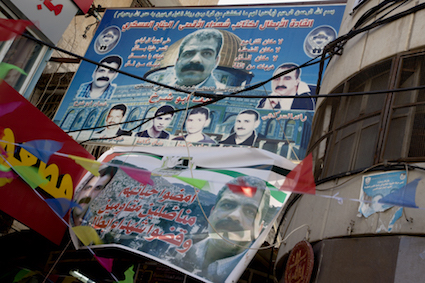 |
Ahlam Shibli, untitled (Death no. 49), Palestine, 2011–12, chromogenic print, 38 x 57 cm. The Old City, al-Kasaba neighborhood, Nablus, February 5, 2012. Banners spanning an alleyway entering the Old City that leads to the house of the family of Naif Abu Sharkh. The larger banner shows Abu Sharkh surrounded by his comrades and reads, "In the name of God, the Entirely Merciful, the Especially Merciful. (And prepare against them whatever you are able of power and of steeds of war by which you may terrify the enemy of Allah and your enemy.) // The hero leaders of al-Aqsa Martyrs Brigades / The military wing // No place for retreat, all leaders to the front / No place for weakness, victory is our guide / No place for humiliation, far from me the occupier / Far from me disgrace, far from me humiliation." Courtesy of the artist, © Ahlam Shibli
|
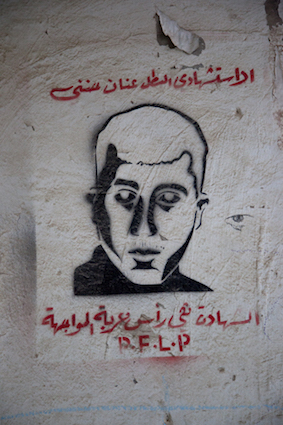 |
Ahlam Shibli, untitled (Death no. 50), Palestine, 2011–12, chromogenic print, 57 x 38 cm. Beit Furik, southeast of Nablus, January 21, 2012. Graffiti on the exterior wall of a house reading, "The martyr hero 'Anan Hanani / Martyrdom is the point of the confrontation bayonet / PFLP." Hanani was killed together with Ahmad Hamad from the village Tal in the region of Nablus in the course of an attack on the Israeli military on Jarzeem Mountain on February 5, 2003. His body was returned to the family on May 31, 2012 together with the bodies of his relatives, the resistance fighters Sa'er, Zeid, and Azhar. Courtesy of the artist, © Ahlam Shibli
|
 |
Ahlam Shibli, untitled (Death no. 51), Palestine, 2011–12, chromogenic print, 57 x 38 cm. The Old City, Nablus, November 23, 2011. On a wall in the market, three commemoration panels surrounded by posters. One panel commemorates the first anniversary of the martyrdom of Mohammad Mar'ei from the Faris al-Leil groups, who was martyred on September 15, 2004. The other one reads, "Al-Aqsa Martyrs' Brigades / The martyr castle / Amin Labada / (The founder of the groups of the Panther Brigades) / If you live, live as a free person, or die standing like the trees." Labada was an explosives expert and started to participate in the resistance at the age of fourteen. The Israeli army arrested his mother several times to pressure him to surrender, and destroyed the house of his family. On April 22, 2007, his hiding place was discovered with the help of a traitor, and Labada was killed with a rocket. Courtesy of the artist, © Ahlam Shibli
|
 |
Ahlam Shibli, untitled (Death no. 52), Palestine, 2011–12, chromogenic print, 57 x 38 cm. New Askar Refugee Camp, January 26, 2012. Poster light box devoted to 'Anan Shalabi in the street leading to the house of his family. "Freedom for the hero prisoner 'Anan Shalabi / Life sentence (for life)." The second light box commemorates the two martyrs Yasser Shawish and Kamal Mallah. Courtesy of the artist, © Ahlam Shibli
|
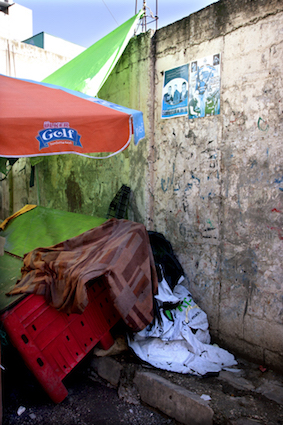 |
Ahlam Shibli, untitled (Death no. 53), Palestine, 2011–12, chromogenic print, 57 x 38 cm. Balata Refugee Camp, November 22, 2011. In the center of the camp, on a street that is used as a market during the day, a poster supporting the prisoners Darwish Shaf'ei, Khalid Abu Hilal, and Mahmoud Mohor. In the upper left corner of the poster, an image of Yasser Arafat and in its right corner an image of the political prisoner Marwan Barghouti, the head of Tanzim, an armed offshoot of Fateh. Next to it, another poster supporting Ahmad Abu Salim, Ahmad Khalil, and Amjad Shaf'ei that has been published on the occasion of the fifth year of their imprisonment by the occupier. Courtesy of the artist, © Ahlam Shibli
|
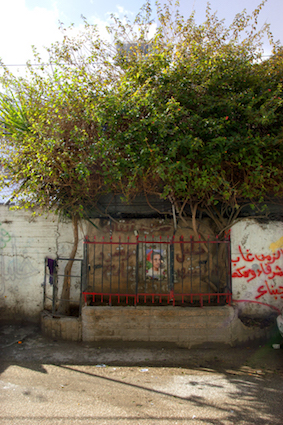 |
Ahlam Shibli, untitled (Death no. 54), Palestine, 2011–12, chromogenic print, 57 x 38 cm. Balata Refugee Camp, January 28, 2012. In the upper neighborhood of the Balata Refugee Camp, a memorial for Khalil Marshoud, a martyr from the al-Aqsa Martyrs' Brigades, graced with a tree to symbolize the continuation of life. On the wall a painted portrait of the martyr, surrounded with the Palestinian colors and adorned with the writing, "The martyr leader, Khalil Marshoud, martyred on 14 June, 2004". On the right side of the memorial a graffiti saying, "Cursed be the time lacking the honorable ones and ruled by cowards." Courtesy of the artist, © Ahlam Shibli
|
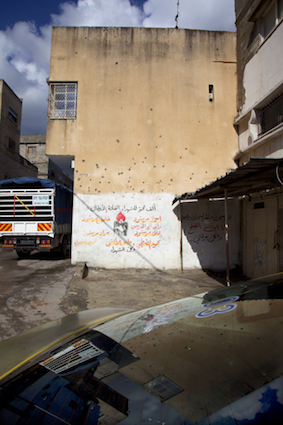 |
Ahlam Shibli, untitled (Death no. 55), Palestine, 2011–12, chromogenic print, 57 x 38 cm. Balata Refugee Camp, January 28, 2012. On the upper half of the house, countless Israeli random bullet marks; at the lower left half, graffiti commemorating "the hero martyrs Ahmad, 'Ala', Murad and Khalil Marshoud, Ra'ed Abu al-'Adas, Mahmoud al-Titi, Wael 'Araishi, Hamouda Shtewei and all the martyrs." At the lower right, graffiti reading, "Neither prison nor guards terrorize me / I am the son of Fateh / and everyone knows me..." followed by the writing, "Love you till death," on the iron gate next to the house. Courtesy of the artist, © Ahlam Shibli
|
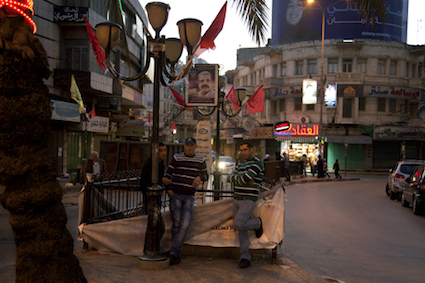 |
Ahlam Shibli, untitled (Death no. 56), Palestine, 2011–12, chromogenic print, 38 x 57 cm. City center, Nablus, March 9, 2012. A memorial for the resistance leader, the martyr Naif Abu Sharkh, with the shape of the Palestinian map carrying text in the Palestinian colors that enumerates his positions. Attached to electricity poles behind the light box are posters commemorating the martyrs Rami Tofaha and Osaid Qadoos, who were killed as defenders of the lands of the village Iraq Burin on March 21, 2010. In front of Abu Sharkh's memorial stands, together with a friend, Abu Sharkh's son Fathi who was recently released after passing nine years in Israeli prisons. Courtesy of the artist, © Ahlam Shibli
|
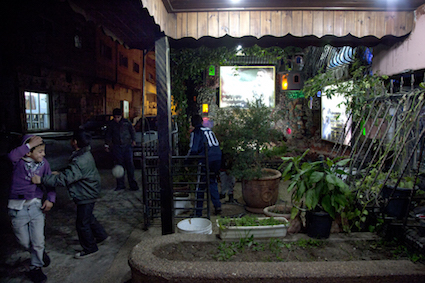 |
Ahlam Shibli, untitled (Death no. 57), Palestine, 2011–12, chromogenic print, 38 x 57 cm. Balata Refugee Camp, February 16, 2012. Attached to the house of the family, a memorial for the martyr Khalil Marshoud, a militant from the al-Aqsa Martyrs' Brigades, with plants to symbolize the continuation of life. On the wall, light boxes with the martyr's portraits and writing describing his beliefs. Most of the children of the family, the sons of Marshoud's various brothers, are named after him. Courtesy of the artist, © Ahlam Shibli
|
 |
Ahlam Shibli, untitled (Death no. 58), Palestine, 2011–12, chromogenic print, 38 x 57 cm. Balata Refugee Camp, November 22, 2011. "Neither prison nor guard terrorize me / the prisoner Haitham Ka'abi / the son of the Balata Refugee Camp's resistance / arrested on August 2, 2006". Next to it, the lower part of the wall is full of graffiti supporting the prisoners. On the front of the wall are the words, "Thousands of greetings to the valiant prisoners in the Zionist prisons, and freedom is coming soon." Courtesy of the artist, © Ahlam Shibli
|
 |
Ahlam Shibli, untitled (Death no. 59), Palestine, 2011–12, chromogenic print, 100 x 66.7 cm. Balata Refugee Camp, March 6, 2012. Posters covering the iron gate of a shop, among them a poster exhibiting the picture of Yasser Arafat and the writing, "Palestinian National Liberation Movement / Nablus region / We are following your way." A second poster is devoted to the martyr Ahmad Hleylah from Fateh, in the Jericho region, who fell in defense of Jerusalem on May 29, 2001, in 'Aqbat Jaber. The walls of the adjacent shop are covered with pictures and posters of Arafat, and different posters of martyrs. Courtesy of the artist, © Ahlam Shibli
|
 |
Ahlam Shibli, untitled (Death no. 60), Palestine, 2011–12, chromogenic print, 100 x 66.7 cm. The Old City, Nablus, November 25, 2011. The poster is devoted to the martyr Ra'ed Tbilah. It reads, "In the name of God, the Entirely Merciful, the Especially Merciful / And the earth will shine with the light of its Lord, and the record [of deeds] will be placed, and the prophets and the witnesses will be brought, and it will be judged between them in truth, and they will not be wronged. / Al-Aqsa Martyrs' Brigades wedding their hero martyr / Ra'ed Hani Tbilah / the field commander of the Faris al-Leil groups (engineer number three), martyred on May 12, 2006 / You lived as a great man and you fell as a resistance martyr / Before you the glory kneels." Tbilah was shot in the head in a clash with the Israeli army in the Old City of Nablus. When the ambulance drove him to a hospital he was arrested at the Hawara Israeli military checkpoint south of Nablus, where he bled to death. The portrait of Tbilah shows him preparing an IED (Improvised Explosive Device), and surrounded by portraits of fellow resistance fighters. Courtesy of the artist, © Ahlam Shibli
|
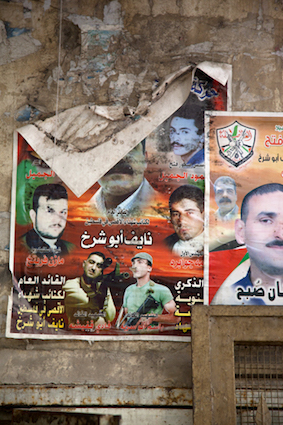 |
Ahlam Shibli, untitled (Death no. 61), Palestine, 2011–12, chromogenic print, 100 x 66.7 cm. The Old City, Nablus, November 23, 2011. The first poster shows a portrait of Naif Abu Sharkh, the General Secretary of al-Aqsa Martyrs' Brigades in Nablus, martyred on June 26, 2004. He is surrounded by portraits of martyred comrades, among them the number one engineer of al-Aqsa Martyrs' Brigades for Nablus, Usama Jawabra, martyred on June 24, 2001; the commander Basim Abu Sariyah (al-Gaddafi), martyred on 16 October, 2007; the commander Fadi Qfeesha, martyred in al-Qarioun neighborhood of the Old City of Nablus in a clash with the Israeli forces on August 31, 2006; and Mazen Freitakh, martyred on April 15, 2003. The second poster shows the emblem of al-'Asifah, an armed offshoot of Fateh, and the portrait of 'Anan Sobh who was assassinated together with his resistance comrades Rassan Abu Sharkh and Ra'ed al-Sarakji on December 26, 2009. Courtesy of the artist, © Ahlam Shibli
|
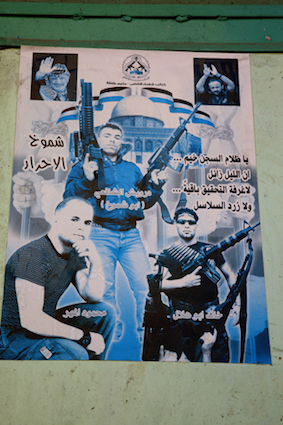 |
Ahlam Shibli, untitled (Death no. 62), Palestine, 2011–12, chromogenic print, 100 x 66.7 cm. Balata Refugee Camp, November 22, 2011. A poster supporting the prisoners Darwish Shaf'ei, Khalid Abu Hilal, and Mahmoud Mohor. In the left upper corner of the poster an image of Yasser Arafat and in its right corner an image of the political prisoner Marwan Barghouti, a member of the Palestinian Legislative Council, and a General Secretary of the Fateh movement in the West Bank. Courtesy of the artist, © Ahlam Shibli
|
 |
Ahlam Shibli, untitled (Death no. 63), Palestine, 2011–12, chromogenic print, 100 x 66.7 cm. The Old City, Nablus, February 4, 2012. The poster, devoted to the martyr Hani al-'Akkad reads, "The National Resistance Brigades / State of Palestine / Wedding to our people one of its prominent commanders / The martyr the hero / Hani al-'Akkad / Covenant / We are following your way / Who became a martyr in defense of the homeland on September 15, 2004." In Nablus, al-'Akkad was a leading figure of the Palestinian National Resistance Brigades, the military wing of the DFLP (Democratic Front for the Liberation of Palestine). He was in charge of building remote-controlled IEDs (Improvised Explosive Devices) and responsible for preparing different martyr operations against the Israeli settlements in the West Bank, carried out by Mahmoud Hanani, Zaid Hanani, and Ahmad Saleh. He was martyred in an armed clash with Israeli forces in the al-Qarioun neighborhood of the Old City in Nablus. Courtesy of the artist, © Ahlam Shibli
|
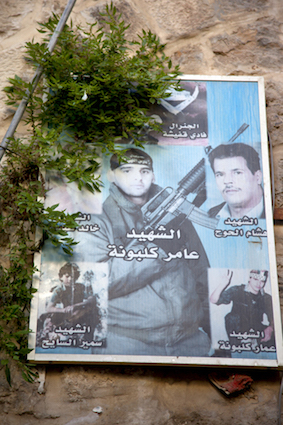 |
Ahlam Shibli, untitled (Death no. 64), Palestine, 2011–12, chromogenic print, 100 x 66.7 cm. The Old City, Nablus, February 4, 2012. The poster is devoted to the martyr Amir Kalbonah. He was a fighter, a member of a Faris al-Leil groups, and was martyred in a clash with the Israeli forces at the Khan al-Tujjar in the Old City of Nablus on February 1, 2007 together with his comrade Wa'el 'Awad. Kalbonah's portrait is surrounded by his resistance comrades, among them the martyrs Fadi Qfeesha, Hisham al-Hawah, 'Amar Kalbonah, and Samir al-Sayeh. Courtesy of the artist, © Ahlam Shibli
|
 |
Ahlam Shibli, untitled (Death no. 65), Palestine, 2011–12, chromogenic print, 100 x 66.7 cm. Beit Furik, southeast of Nablus, January 21, 2012. Two posters on the exterior wall of a house. One exhibits, together with two other martyrs, the portrait of Sa'ed Hanani of the Abu Ali Mustafa Brigades, the military arm of the PFLP. Hanani's photo was taken on the same day he carried out a martyrdom operation in Israel on December 25, 2003. The Israeli army destroyed the family house as punishment. The second poster is devoted to the lieutenant colonel Mahmoud NasrAllah who spent fifteen years in Israeli jails. In 1983 he was exiled to Jordan where he worked in the care of the families of prisoners and martyrs. In 1997 he returned to his village Beit Furik, where he died on August 14, 1998. Courtesy of the artist, © Ahlam Shibli
|
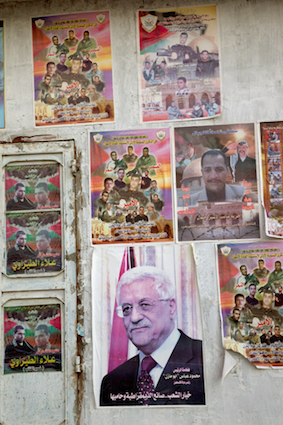 |
Ahlam Shibli, untitled (Death no. 66), Palestine, 2011–12, chromogenic print, 100 x 66.7 cm. New Askar Refugee Camp, January 25, 2012. Posters on a house wall. One poster, baring the portrait of Mahmoud Abbas reads, "His Excellence the President / Mahmoud Abbas 'Abu Mazen' / President of the State of Palestine / People's choice... Maker and protector of the democracy." The poster was made on the occasion of Abbas's formal request, in the name of the Palestinian people, for full membership of Palestine in the United Nations. The poster appearing three times and carrying several portraits of martyrs from al-Aqsa Martyrs' Brigades of the Balata Refugee Camp describes three of the men, each with a different epithet: 'Ala' al-Terawi, "The Conscience"; Wa'el Rayahi, martyred by Israeli special forces on December 17, 2004, "The Panther"; and Mohammad Ishtiwi, Commander at the Central Command, "The Prince." The latter was killed together with another two resistance comrades, Mohammad 'Amar and Hosni Hajaj, on February 23, 2006 by the Israeli army, when their hiding place was discovered with the help of Jaffal Srour, a local traitor. Courtesy of the artist, © Ahlam Shibli
|
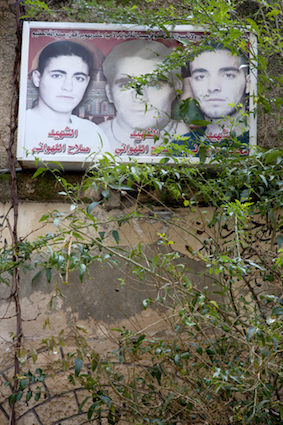 |
Ahlam Shibli, untitled (Death no. 67), Palestine, 2011–12, chromogenic print, 100 x 66.7 cm. Balata Refugee Camp, January 28, 2012. Next to the house of the al-Lahwaani family, a memorial for their three martyrs: the two sons, Mahmoud and Salah, and, in the middle, their father Saleh. Salah was killed on June 15, 2004 on the occasion of the funeral of the martyrs Khalil Marshoud and 'Awad Abu Zeid, by the Israeli army that also attacked Salah's own funeral, increasing the number of people from Balata who were injured that day, in addition to dozens of other citizens who suffered suffocation from tear gas, which was flooded out by the army during the martyr's funeral. On July 3, 2004, eighteen days after the death of his brother Salah, Mahmoud was shot by the Israeli army during one of their successive incursions at the same place where Salah died, the southern entrance of the camp. Years earlier a mysterious accident claimed the life of their father in Israel. Courtesy of the artist, © Ahlam Shibli
|
 |
Ahlam Shibli, untitled (Death no. 68), Palestine, 2011–12, chromogenic print, 100 x 66.7 cm. Balata Refugee Camp, March 6, 2012. A poster on the wall facing the entrance of the family house of the martyrdom operator Ahmad Khatib reads, "On the second anniversary / The martyr Ahmad Khatib's mother wedding her son and all Palestine's martyrs / The hero prisoner Mohammad Khatib / The hero martyr Ahmad Khatib, 'Abu Bilal,' martyred on April 24, 2003 / The hero martyr Majdi Khaloos, 'Abo Anas,' martyred on April 5, 2002 / Who honors the martyr follow his steps / And we are faithful to the covenant." Ahmad Khatib was sixteen years old when he carried out a martyrdom operation inside Israel, where he died. Mohammad Khatib, his oldest brother, was on the Israeli wanted list up until they kidnapped him. Courtesy of the artist, © Ahlam Shibli
|
